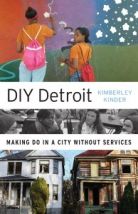DIY Detroit: Making Do in a City without Services

Plenty has been written about Detroit as a cautionary tale of urban decay – from its industrial manufacturing heyday to its persistent problems with racism, poverty and mass flight to the suburbs. This book focuses on the individuals who have responded to these challenges by furnishing their own basic services.
The Detroiters profiled by Kimberley Kinder had diverse backgrounds and motivations for stepping into the breach left by governmental neglect. But they “shared the problems of global restructuring, regional racism, and municipal insolvency. They also developed similar self-provisioning responses to those constraints” (11).
Kinder’s methodology involved interviews and participant observation at community events, across several neighbourhoods. She organized her findings into six areas of self-provisioning: recruiting new residents, defending vacant homes, repurposing abandonment, performing public works, improving public safety, and producing local knowledge.
Kinder situates the practices in Detroit against the historical context of “self-provisioned urbanism”, and the structural context of real estate. She is clear-eyed about the limits to self-provisioning, calling it a weak weapon against a legacy of urban dysfunction.
She also investigates the diverse motivations for such individually or community-driven practices. For example, she describes Detroit’s “resident realtors”: neighbours who informally help to find residents for vacant homes. Without the finances to purchase and maintain additional housing, resident realtors might use their non-financial resources, such as social networks, to match homes with occupants. Working toward vibrant neighbourhoods might help these resident realtors as property owners and as civic-minded people. But Kinder’s interviewees also pointed to benefits around making communities safer, in narrowly defined ways. This involved judgements about acceptable neighbours that, alongside market mechanisms, effectively excluded low-income people.
Thus, even when describing impressive ingenuity and hard work in self-provisioning, Kinder’s intention is not to draw attention away from governmental neglect and economic exclusion.
Further reading:
Environment and Urbanization (1994), “Service provision in cities”, Vol 6, No 2, available at http://eau.sagepub.com/content/6/2.
Katz, Bruce and Jennifer Bradley (2009), “How to Save Detroit: A plan for America’s greatest urban disaster”, New Republic, 9 December, available at https://newrepublic.com/article/71758/the-detroit-project.
Silver, Hilary (2015), “Editorial: The Urban Sociology of Detroit”, City & Community Vol 14, No 2, pages 97–101, available at http://www.asanet.org/journals/CC/Jun15CCFeature.pdf.
Book note prepared by Christine Ro
Search the Book notes database
Our Book notes database contains details and summaries of all the publications included in Book notes since 1993 - with details on how to obtain/download.
Use the search form above, or visit the Book notes landing page for more options and latest content.
For a searchable database for papers in Environment and Urbanization, go to http://eau.sagepub.com/

